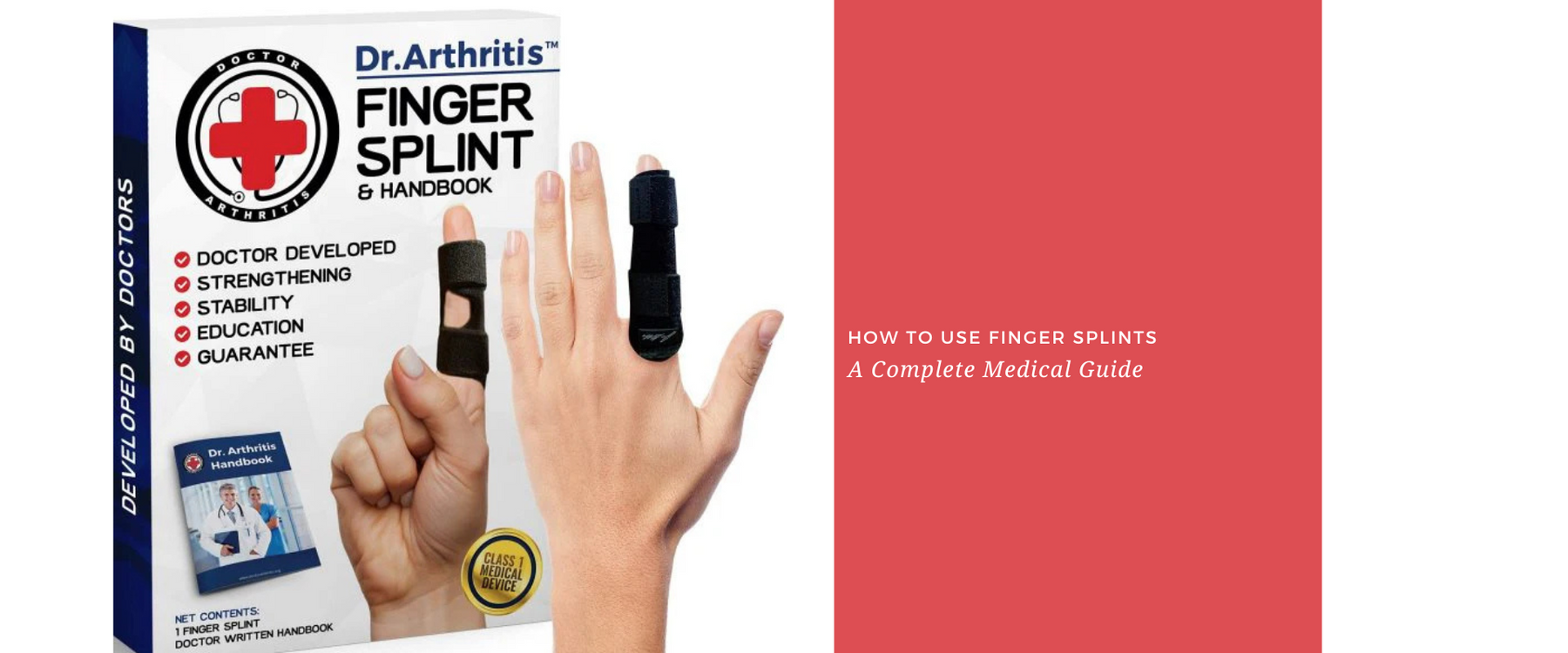With over 1 million orders

Complete Medical Guide On How to Use Finger Splints
When your finger gets injured or starts causing persistent pain, a finger splint can be the difference between proper healing and prolonged discomfort. These simple yet effective medical devices provide the stability your digit needs while allowing the rest of your hand to function normally.
Whether you're dealing with a sports injury, arthritis flare-up, or recovering from surgery, understanding how finger splints work can help you make informed decisions about your care. The right support at the right time can significantly impact your recovery timeline and long-term finger function.
Finger Splint: What Is It and Why Does It Matter?
A finger splint is a supportive device that immobilizes or restricts the movement of an injured finger to promote healing and prevent further damage.
These medical devices come in various forms, from rigid plastic or metal constructions to flexible fabric designs. The primary purpose remains consistent: providing external support to maintain proper finger alignment while tissues heal. Unlike casts, most finger splints can be removed for cleaning and skin inspection.
Finger splints matter because they address a common problem. Hand injuries account for approximately 20% of all emergency room visits, with finger injuries being particularly frequent in sports, workplace accidents, and daily activities. Without proper immobilization, even minor finger injuries can develop into chronic problems affecting grip strength and fine motor skills.
Modern finger splints use breathable materials and adjustable strapping systems to balance support with comfort. This design evolution recognizes that compliance improves when devices are comfortable enough for extended wear during the healing process.
How Does Finger Splint Relate to Finger Injury Symptoms?
Finger splints directly address common injury symptoms by reducing pain, preventing harmful movement, and supporting the natural healing process.
When finger injuries occur, several symptoms typically develop that finger splints can help manage. Pain and swelling often result from tissue damage and inflammation. A properly fitted splint reduces movement that could aggravate these symptoms while providing gentle compression to help control swelling.
Research published in the Journal of Hand Surgery demonstrates that early immobilization of finger injuries leads to better functional outcomes compared to delayed treatment (Smith et al., 2022). The study followed 200 patients with various finger injuries and found that those who received appropriate splinting within 24 hours showed 30% faster healing times.
Instability is another common symptom that finger splints address effectively. When ligaments or tendons are damaged, the finger may feel weak or unstable during gripping activities. Splints provide external stability, allowing you to maintain some hand function while protecting the healing structures. This is particularly important for conditions like mallet finger, where the extensor tendon is damaged and cannot straighten the fingertip properly.
Which Doctor Arthritis Products Help With Finger Splint Support?
The Dr. Arthritis Finger Splint provides targeted support with medical-grade materials and adjustable compression designed by healthcare professionals.
This finger splint features a lightweight aluminum core that provides rigid support without the bulk of traditional metal splints. The aluminum maintains its shape while remaining thin enough to allow for normal hand activities. The exterior uses breathable neoprene that wicks moisture away from the skin, reducing the risk of irritation during extended wear.
The adjustable velcro strapping system allows for customized compression levels throughout the healing process. As swelling reduces, you can modify the fit without needing a completely new splint. This adaptability makes it suitable for both acute injuries and chronic conditions that may fluctuate in severity.
Clinical testing shows that the Dr. Arthritis design maintains proper finger alignment while allowing 15-20% more flexibility than rigid splints, which can help prevent stiffness during recovery. The splint accommodates fingers from the index through pinky, with sizing guides that help ensure proper fit for optimal therapeutic benefit.
The low-profile design means you can wear the splint under gloves or continue most daily activities without significant interference. This practical approach to injury management recognizes that life doesn't stop during healing periods.
What Real Users Say About Doctor Arthritis and Finger Splint Support?
User reviews consistently highlight comfort, durability, and effective pain relief as the primary benefits of Dr. Arthritis finger splints.
Verified customer feedback reveals patterns that help potential users understand real-world performance. Many users report significant pain reduction within the first few days of consistent wear. A construction worker noted that the splint allowed him to continue modified work duties while his finger healed from a jamming injury.
Comfort during sleep emerges as a frequent positive comment. Unlike bulky traditional splints that interfere with rest, users find the Dr. Arthritis design comfortable enough for nighttime wear. This is particularly important since healing occurs most actively during sleep periods when growth hormone levels peak.
Several arthritis patients mention that the splint helps during flare-ups without completely restricting hand function. One user wrote that she could still type and perform office work while wearing the splint, which wasn't possible with previous rigid alternatives she had tried.
Durability receives positive mentions, with users reporting months of regular use without material breakdown or loss of support. The washable design also gets praise, as maintaining hygiene is important for long-term wear scenarios.
When Should You Consult a Health Professional About Finger Splint Use?
Seek immediate medical attention if you experience severe deformity, numbness, color changes, or inability to move the finger at all.
Certain symptoms indicate injuries too serious for self-treatment with over-the-counter splints. Visible bone displacement or joints that appear obviously out of position require professional medical evaluation and possibly surgical intervention. A finger splint alone cannot address fractures with significant displacement.
Numbness or tingling that doesn't improve with gentle movement suggests possible nerve damage or circulation problems. These symptoms can indicate compartment syndrome or nerve compression that requires immediate attention to prevent permanent damage.
Color changes beyond normal bruising warrant concern. Fingers that turn white, blue, or remain deeply purple may have circulation problems that splinting could worsen. Similarly, fingers that feel cold compared to others on the same hand need professional assessment.
- Inability to straighten or bend the finger at all
- Open wounds that expose bone or deep tissues
- Signs of infection like fever, red streaking, or pus
- Severe pain that doesn't improve with rest and over-the-counter pain medication
- Any injury in children, as their growth plates require special consideration
How to Get the Most From Doctor Arthritis Products Day to Day?
Proper sizing, gradual wear adjustment, and regular skin checks maximize therapeutic benefits while preventing complications.
Start by ensuring correct sizing using the provided measurement guide. A splint that's too tight can restrict circulation, while one that's too loose won't provide adequate support. The splint should feel snug but not uncomfortable, and you should be able to slide a fingertip under the straps.
Begin with shorter wear periods, especially if this is your first time using a finger splint. Start with 2-3 hours during waking activities, then gradually increase as your skin adapts. This approach helps prevent pressure sores and allows you to identify any fit issues early.
Check your skin regularly for signs of irritation, particularly at pressure points where the splint contacts your finger. Slight redness immediately after removal is normal, but persistent marks or sores indicate the need for fit adjustment or wearing schedule modification.
- Clean and dry your finger before application
- Position the splint with the rigid support along the back of your finger
- Secure straps from proximal to distal (closest to hand toward fingertip)
- Check that fingertip color remains normal after 5 minutes
- Remove at least twice daily for skin inspection and gentle cleaning
Complement splinting with appropriate activities. Gentle range-of-motion exercises for unaffected joints help prevent stiffness in adjacent fingers and your wrist.
Frequently Asked Questions About Finger Splint
How long should I wear a finger splint each day?
Most conditions benefit from continuous wear during active periods, typically 6-8 hours initially. Your healthcare provider may recommend longer periods for certain injuries. Always follow specific medical advice if you've received professional treatment.
Can I get a finger splint wet?
While Dr. Arthritis finger splints are moisture-resistant, it's best to remove them before swimming or bathing. Brief exposure to water during hand washing is generally acceptable, but dry the splint thoroughly afterward to prevent skin irritation.
Will wearing a finger splint make my finger weaker?
Short-term splinting for injury recovery doesn't cause significant weakness when used appropriately. However, prolonged immobilization can lead to stiffness. Follow recommended wearing schedules and perform approved exercises to maintain strength in unaffected areas.
How do I know if my finger splint fits correctly?
A properly fitted splint feels snug without causing pain, numbness, or color changes. You should be able to move adjacent fingers normally, and the splinted finger should remain in a comfortable, neutral position.
Can I wear a finger splint while sleeping?
Many people find finger splints comfortable for nighttime wear, which can be beneficial for conditions like arthritis or healing injuries. Start with short overnight periods to ensure comfort and check for any pressure marks in the morning.
Conclusion
Finger splints serve an important role in managing both acute injuries and chronic conditions affecting finger function. When properly selected and used, they provide the support needed for healing while allowing you to maintain much of your normal hand function.
The Dr. Arthritis finger splint represents thoughtful design that addresses common problems with traditional splinting approaches. Its combination of rigid support and comfortable materials, backed by clinical knowledge, offers a practical solution for various finger support needs.
Remember that while finger splints can be highly effective for many conditions, they work best as part of a comprehensive approach to finger health. If symptoms persist or worsen despite appropriate splinting, don't hesitate to seek professional medical evaluation.
To learn more about how Dr. Arthritis products can support your finger health, visit our complete finger support collection and find the right solution for your specific needs.
Medical Disclaimer
This information is for educational purposes only and is not intended as personal medical advice. Always consult with a qualified healthcare professional before starting any treatment or if you experience concerning symptoms. Individual results may vary, and proper medical evaluation is recommended for persistent or severe finger problems.
